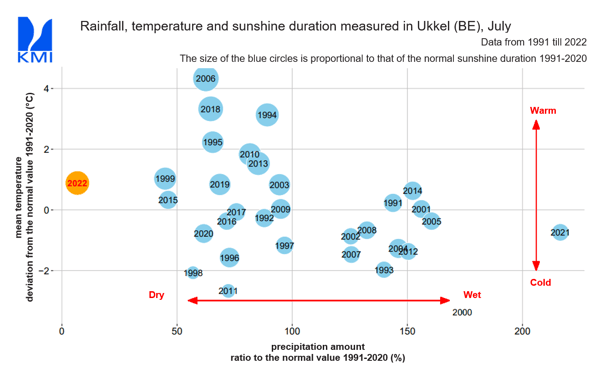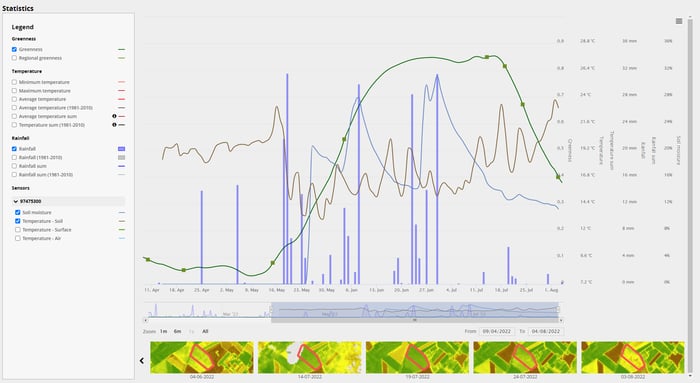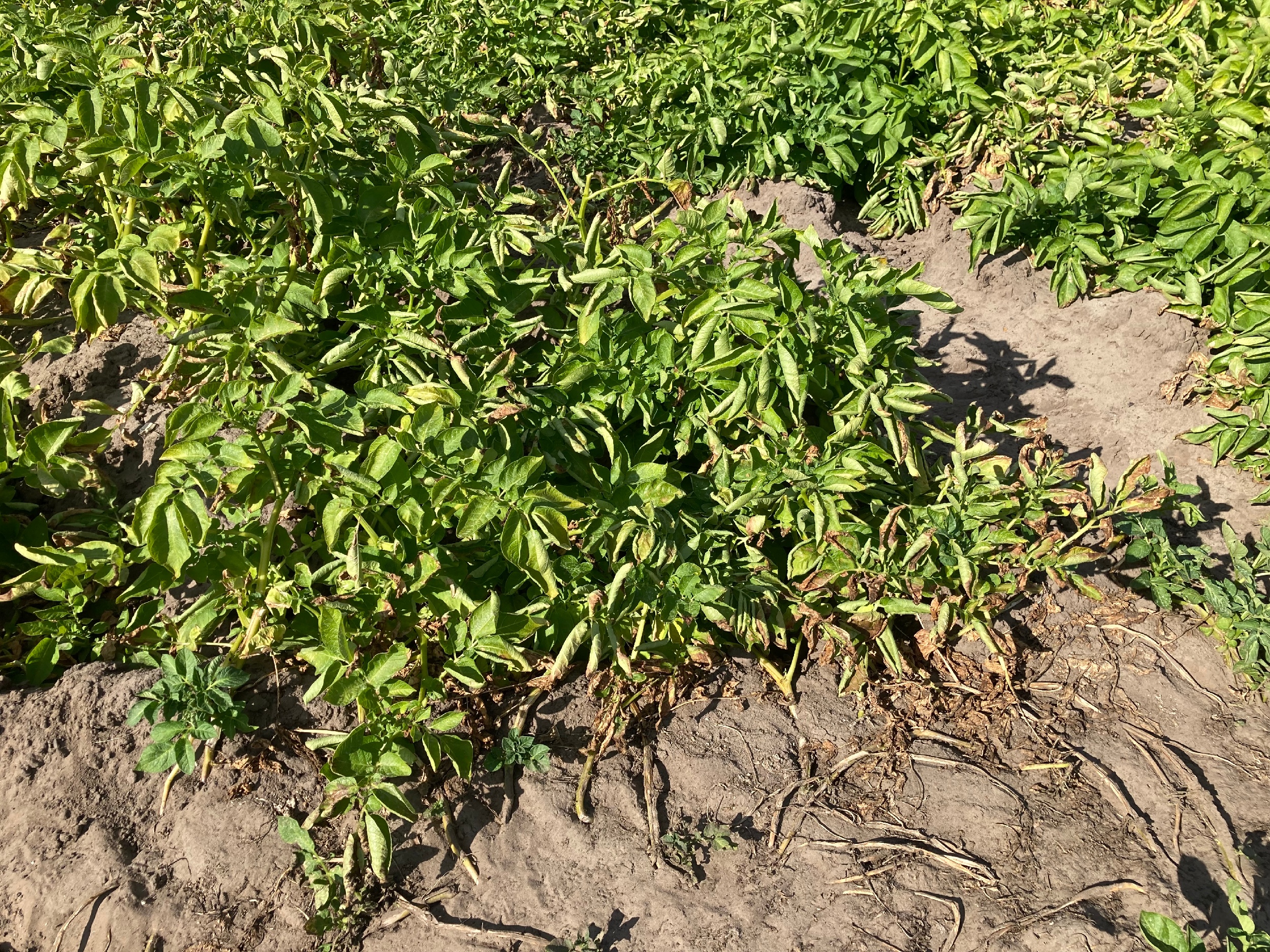The summer of 2022, exceptional dry! Or not any longer exceptional?
5,2 mm… that is the amount of rain reported for the month of July by the meteorological station of Brussels (Ukkel) in Belgium. The normal amount over the last 30 years is 77 mm. Only in 1885 it was even drier with 3 mm, but while this was very exceptional 137 years ago the actual drought is the fifth in the last six years. Also spring was very dry with a total amount of rainfall of 108 mm instead of the average 165 mm.
The lack of rain comes with high temperatures - especially in the last weeks - resulting in an actual shortage of 250-275 mm of water, and the summer isn’t over yet. Most parts of western Europe face a similar situation while southern Europe is caught in a long and sizzling heat wave.
The figure below illustrates the temperature and precipitation for July 2022. Note the extreme difference with July 2021 which was exceptionally wet.

Rainfall, temperature and sunshine duration measured in Ukkel (BE), July
The pattern of long dry spells and heat waves, interrupted by short episodes of intense rainfall, seems to be the new normal. While many of us love a warm & dry summer season, it is a dramatic evolution for the agriculture, nature and water supply in western Europe. Wheat, corn, sugar beet, vegetables, and grassland all benefit from the typical “Belgian weather” with regular rainfall and moderate temperatures.
CurieuzeNeuzen tracks the heat and drought in Belgium
In 2021 ‘CurieuzeNeuzen in de Tuin’ was kicked off. This unique citizen science project measures the impact of heat and drought in Flanders (BE) by installing thousands of temperature and soil moisture sensors in private gardens, public green spaces and agricultural fields (focus on the cultivation of potatoes). However, the summer of 2021 turned out to be the wettest summer ever in Belgium. Despite the unexpected conditions a unique dataset could be collected and analyses have been made. Joris De Wolf explains what the measurements in a cool and wet season tell us in our previous blog ‘Citizen science in a potato fields: what did it teach us?’
This year the experiment is repeated with 3000 sensors of which 200 are installed on potato fields across Flanders. Why potatoes? The potato is closely intertwined with the traditional appreciation of good food in Belgium and above all in Flanders, the northern half of the country, the ideal soil and growing conditions and an optimal climate form the basis of successful potato cultivation. Long episodes of drought, heat waves and intensive rains lead to an inferior quality and decreased production.
Unlike last year, we only placed sensors in fields cultivating Fontane, as the dominant variety in Flanders. In this way we reduce the variability in the data set. Of course, differences in soil remain important in the analysis. This experiment gives us unique insights on the impact of heat and drought on the cultivation of potatoes.
The impact on our potatoes
While the sensors will collect data until the end of the growing season, we can monitor the measurements as from the installation of the sensor via WatchITgrow, our online platform supporting growers to monitor their crops. Let’s take a look at the measurement of a potato field in the sandy region of the ‘Kempen’ in the province of Antwerp.
The figure below shows the evolution of the fAPAR (“greenness” – green curve). While the blue bars represent the daily precipitation, the blue line shows the soil moisture and the brown line the soil temperature as measured by the CurieuzeNeuzen sensor (hence in the upper 15 cm of the soil). These statistics clearly show that the onset of the season was pretty perfect with favourable conditions in May and June but the drought of July and the exceptional heat on July 19 (till 40°C) changed the picture and we witness a decline in the fAPAR from mid-July onwards. Especially in the past two weeks there is a clear deterioration of the leaf foliage with dried and yellow leaves appearing.

Printscreen of field statistics available in WatchITgrow
Yield expectations
How will this situation evolve and possibly impact the yield? We contacted Ilse Eeckhout, scientific coordinator at the test centre for potato cultivation in Flanders (PCA). She states that “Till mid-July the growth curve and the yield estimation was rather normal. However, the situation deteriorated rapidly in the past two weeks under exceptional dry and sunny conditions. Today we measure approximately 35 ton/ha on the field, which is 15% below normal (Fontane variety). If the rain arrives soon further damage could be limited, especially for the late planted fields, but time is pressing as we witness plants turning yellow. Once the foliage is dead the potatoes stop growing and rain won’t help anymore. Therefore, we need rain very soon. The next days are actually critical.” We keep monitoring the situation closely with the help of the CurieuzeNeuzen sensors.
While these field devices provide in-situ data our remote sensing imagery provides the spatial overview, revealing the health status of the crops on the field. For the monitoring of the potato fields a combination of Sentinel-1 and Sentinel-2 is used. The optical data of the latter provides information on the biophysical status of the crop, while the radar observations of Sentinel-1 are sensitive to the crop structure. Moreover, radar data look through the clouds and hence allow for continuous weather-independent monitoring. Hereto we use our CropSAR algorithm.
The in-situ data will be added to WatchITgrow. The new field data will be combined with remote sensing data as well as other in-situ data using big data analytics and machine learning to provide growers with more timely and personalized advice.



/Blog_CORSA_1200x650.png)
/Blog_WorldCereal_1200x650.png)
/lewis-latham-0huRqQjz81A-unsplash.jpg)